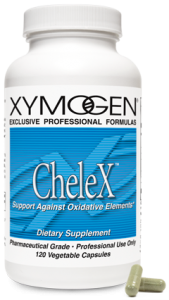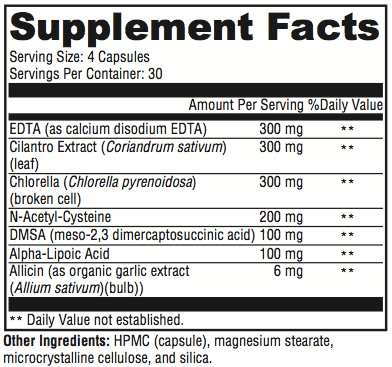CheleX

EDTA (ethylenediaminetetraacetic acid) is a synthetic amino acid compound and perhaps the most well-known and often-used IV chelating agent. Oral EDTA is poorly absorbed, but it is believed to support detoxification of metals largely in the gastrointestinal tract.[6,7] More studies are needed to validate this approach. There is believed to be a benefit in combining EDTA with other chelators because EDTA acts slowly and could potentially lead to redeposition of metals.[8] Due to EDTA’s metal-binding ability, it is important to replace beneficial minerals, such as zinc, copper, iron, cobalt, and manganese.*
Cilantro (Coriandrum sativum), also known as Chinese parsley or coriander, suppresses the deposition of lead by chelating the metal.[9] Furthermore, in an experimental animal study, lead-induced histological changes in testis of albino mice were prevented to some extent by concomitant daily administration of C sativum extracts, perhaps due to a reduction in associated oxidative stress.*[10]
Allicin is the main biologically active component of garlic clove extracts and has promising effects on toxic metal accumulation in experimental research.[11] In animal and in vitro models, garlic was able to reduce cellular exposure to, or accumulation of, lead, cadmium, and mercury.[12-14] Furthermore, various extracts and forms of garlic have demonstrated its ability to positively affect detoxification pathways.*[15]
Chlorella is a naturally occurring micro-algae and an excellent source of chlorophyll—a detoxifying substance that is also thought to bind toxic metals. The positive effect of chlorella supplementation on toxic metals, including methylmercury and lead, is supported by animal research.[16,17] For example, testing its metal chelating ability, researchers observed a dramatic 66.03% reduction in blood lead levels in mice receiving chlorella extract (50 mg/kg/day) concurrent with lead exposure compared to lead-exposed, non-treated mice.*[16]
N-Acetyl-L-Cysteine (NAC) and Alpha Lipoic Acid are well-known for their antioxidant activity. Exposure to heavy metals increases free radical production and oxidative stress.[18] Research suggests that there is a beneficial role for free radical scavengers in reducing the oxidative stress that is common with toxic metal exposure.[19] NAC has the ability to interact with reactive oxygen species (ROS) and stimulate the body to produce glutathione. This can enhance cell survival after exposure to heavy metals or toxins.[20] In addition, ALA may directly chelate or reduce the oxidative capacity of metals, such as copper, arsenic, cadmium, and mercury.*[21-24]
Directions
Take 2-4 capsules twice daily, unless otherwise directed
References
- Crinnion WJ. EDTA redistribution of lead and cadmium into the soft tissues in a human with a high lead burden – should DMSA always be used to follow EDTA in such cases? Altern Med Rev. 2011 Jun;16(2):109-12. [PMID: 21649453]
- Bradberry S, Sheehan T, Vale A. Use of oral dimercaptosuccinic acid (succimer) in adult patients with inorganic lead poisoning. QJM. 2009 Oct;102(10):721-32. [PMID: 19700440]
- Palaniappan PL, Vijayasundaram V. The effect of arsenic exposure and the efficacy of DMSA on the proteins and lipids of the gill tissues of Labeo rohita. Food Chem Toxicol. 2009 Aug;47(8):1752-59. [PMID:19394394]
- Kim LH, Abel SJ. Survival after a massive overdose of arsenic trioxide. Crit Care Resusc. 2009 Mar;11(1):42-45. [PMID: 19281444]
- Lee BK, Schwartz BS, Stewart W, et al. Provocative chelation with DMSA and EDTA: evidence for differential access to lead storage sites. Occup Environ Med. 1995 Jan;52(1):13-19. [PMID: 7697134]
- Foreman H, Trujillo TT. The metabolism of C14 labeled ethylenediaminetetraacetic acid in human beings. J Lab Clin Med. 1954 Apr;43(4):566-71. [PMID: 13163555]
- Shiels DO, Thomas DL, Kearley E. Treatment of lead poisoning by edathamil calcium-disodium. AMA Arch Ind Health. 1956 May;13(5):489-98. [PMID: 13312679]
- Besunder JB, Super DM, Anderson RL. Comparison of dimercaptosuccinic acid and calcium disodium ethylenediaminetetraacetic acid versus dimercaptopropanol and ethylenediaminetetraacetic acid in children with lead poisoning. J Pediatr. 1997 Jun;130(6):966-71. [PMID: 9202621]
- Aga M, Iwaki K, Ueda Y, et al. Preventive effect of Coriandrum sativum (Chinese parsley) on localized lead deposition in ICR mice. J Ethnopharmacol. 2001 Oct;77(2-3):203-08. [PMID: 11535365]
- Sharma V, Kansal L, Sharma A. Prophylactic efficacy of Coriandrum sativum (Coriander) on testis of lead-exposed mice. Biol Trace Elem Res. 2010 Sep;136(3):337-54. [PMID: 19902160]
- Aslani MR, Najarnezhad V, Mohri M. Individual and combined effect of meso-2,3-dimercaptosuccinic acid and allicin on blood and tissue lead content in mice. Planta Med. 2010 Feb;76(3):241-44. [PMID: 19764011]
- Senapati SK, Dey S, Dwivedi SK, et al. Effect of garlic (Allium sativum L.) extract on tissue lead level in rats. J Ethnopharmacol. 2001 Aug;76(3):229-32. [PMID: 11448543]
- Jiang W, Liu D, Hou W. Hyperaccumulation of cadmium by roots, bulbs and shoots of garlic (Allium sativum L.). Bioresour Technol. 2001 Jan;76(1):9-13 [PMID: 11315815]
- Lee JH, Kang HS, Roh J. Protective effects of garlic juice against embryotoxicity of methylmercuric chloride administered to pregnant Fischer 344 rats. Yonsei Med J. 1999 Oct;40(5):483-9. [PMID: 10565261]
- Melino S, Sabelli R, Paci M. Allyl sulfur compounds and cellular detoxification system: effects and perspectives in cancer therapy. Amino Acids. 2011 Jun;41(1):103-12. [PMID: 20213447]
- Queiroz ML, Rodrigues AP, Bincoletto C, et al. Protective effects of Chlorella vulgaris in lead-exposed mice infected with Listeria monocytogenes. Int Immunopharmacol. 2003 Jun;3(6):889-900. [PMID: 12781705]
- Uchikawa T, Maruyama I, Kumamoto S, et al. Chlorella suppresses methylmercury transfer to the fetus in pregnant mice. J Toxicol Sci. 2011 Oct;36(5):675-80. [PMID: 22008543]
- Vassallo DV, Simões MR, Furieri LB, et al. Toxic effects of mercury, lead and gadolinium on vascular reactivity. Braz J Med Biol Res. 2011 Sep;44(9):939-46. [PMID: 21845340]
- Flora SJ, Pande M, Mehta A. Beneficial effect of combined administration of some naturally occurring antioxidants (vitamins) and thiol chelators in the treatment of chronic lead intoxication. Chem Biol Interact. 2003 Jun 15;145(3):267-80. [PMID: 12732454]
- James SJ, Slikker W 3rd, Melnyk S, et al. Thimerosal neurotoxicity is associated with glutathione depletion: protection with glutathione precursors. Neurotoxicology. 2005 Jan;26(1):1-8. [PMID: 15527868]
- Gaetke LM, Chow CK. Copper toxicity, oxidative stress, and antioxidant nutrients. Toxicology. 2003 Jul 15;189(1-2):147-63. [PMID: 12821289]
- das Neves RN, Carvalho F, Carvalho M, et al. Protective activity of hesperidin and lipoic acid against sodium arsenite acute toxicity in mice. Toxicol Pathol. 2004 Sep-Oct;32 (5): 527-35. [PMID: 15603538]
- Bludovska M, Kotyzova D, Koutensky J, et al. The influence of alpha-lipoic acid on the toxicity of cadmium. Gen Physiol Biophys. 1999 Oct;18 Spec No:28-32. [PMID: 10703716]
- Keith RL, Setiarahardjo I, Fernando Q, et al. Utilization of renal slices to evaluate the efficacy of chelating agents for removing mercury from the kidney. Toxicology. 1997 Jan 15;116(1-3):67-75 [PMID: 9020508]








